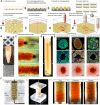Biodegradable Inks in Indirect Three-Dimensional Bioprinting for Tissue Vascularization
- PMID: 35402417
- PMCID: PMC8990266
- DOI: 10.3389/fbioe.2022.856398
Biodegradable Inks in Indirect Three-Dimensional Bioprinting for Tissue Vascularization
Abstract
Mature vasculature is important for the survival of bioengineered tissue constructs, both in vivo and in vitro; however, the fabrication of fully vascularized tissue constructs remains a great challenge in tissue engineering. Indirect three-dimensional (3D) bioprinting refers to a 3D printing technique that can rapidly fabricate scaffolds with controllable internal pores, cavities, and channels through the use of sacrificial molds. It has attracted much attention in recent years owing to its ability to create complex vascular network-like channels through thick tissue constructs while maintaining endothelial cell activity. Biodegradable materials play a crucial role in tissue engineering. Scaffolds made of biodegradable materials act as temporary templates, interact with cells, integrate with native tissues, and affect the results of tissue remodeling. Biodegradable ink selection, especially the choice of scaffold and sacrificial materials in indirect 3D bioprinting, has been the focus of several recent studies. The major objective of this review is to summarize the basic characteristics of biodegradable materials commonly used in indirect 3D bioprinting for vascularization, and to address recent advances in applying this technique to the vascularization of different tissues. Furthermore, the review describes how indirect 3D bioprinting creates blood vessels and vascularized tissue constructs by introducing the methodology and biodegradable ink selection. With the continuous improvement of biodegradable materials in the future, indirect 3D bioprinting will make further contributions to the development of this field.
Keywords: biodegradable ink; indirect 3D bioprinting; scaffold; tissue engineering; vascularization.
Copyright © 2022 Ze, Li, Huang, Shi, Li, Gong, Lin and Yao.
Conflict of interest statement
The authors declare that the research was conducted in the absence of any commercial or financial relationships that could be construed as a potential conflict of interest. The reviewer YD declared a shared affiliation, with no collaboration, with all of the authors to the handling editor at the time of the review.
Figures



References
Publication types
LinkOut - more resources
Full Text Sources

